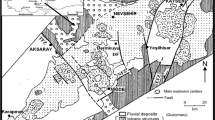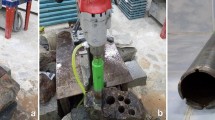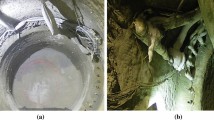Uniaxial compressive strength measurements were made on different artificial rock core samples with different mineral compositions, particle size distributions, permeability, void ratio, and other parameters and subjected to different types of pretreatment. Poisson’s ratio and the elastic modulus of the samples were measured. It was established that the best method for preparing the sample for the measurements is to saturate with water under vacuum and then heat the oil and gas under pressure, simulating formation pressure.
Similar content being viewed by others
Avoid common mistakes on your manuscript.
Currently, during exploration of oil and gas deposits, when simulating formation conditions or studying the effect of evolution of formation fluids on rock strength, the rocks need to be properly pre-treated before measuring uniaxial compressive rock strength. Pretreatment of the sample can involve desiccation [1–7], desiccation by heating, and soaking with a special fluid (cavitation fluid). Desiccation under normal conditions (natural desiccation) presumes air-drying at ambient temperature; desiccation by heating (hot desiccation) involves heating to formation temperature [8–10] and drying by a stream of air with temperature 100°C [11, 12] and above 190°C [13, 14]. Soaking with cavitation fluid involves saturation with the fluid under normal conditions (non-vacuum saturation) [10, 15–24], saturation under vacuum (vacuum saturation) [12, 25–32], and saturation under pressure (pressure saturation) [33]. The saturation fluid is usually pure water, formation water, drilling fluid, acid, solutions of base, salt, and hydrocarbon, i.e., fluids which are typically used to study the strength characteristics of rock. For measuring the permeability of rock samples, before pretreatment for the studies, they were washed to remove oil (oil washing) [34, 35] followed by oil saturation to form the initial oil and water saturation state. In order to measure gas permeability, after vacuum water saturation we need to saturate with gas (gas-drive).
Today there is no single standard for sample pretreatment for void factor measurement, but many methods are available. The large number of rock strength parameters leads to confusion in the data for predicting well-wall stability and sanding, and complicates the process of taking necessary measures. Currently studies are often conducted on natural non-homogeneous rock cores. Artificial rock core samples can be made with prespecified mineral composition and particle size distribution and permeability. The samples having identical properties lets us study the effect of the type of treatment on the rock strength.
The prepared samples of the specified mineral composition have void factor 18% and permeability 192·10–3 μm2. The studies were conducted at a pressure of 28 MPa and a temperature of 105°C. The particle size distribution of the samples is given in Table 1; the constituent composition is given below (wt.%):
Quartz..........................................................................75 |
Feldspar....................................................................... 5 |
Plagioclase................................................................... 2 |
Dolomite....................................................................... 5 |
Siderite......................................................................... 2 |
Clay, including::.........................................................13 |
Illite...................................................................... 41 |
Kaolin................................................................... 27 |
Chlorite................................................................. 10 |
Illite/smectite ratio....................................................20 |
A powder (core sand) was prepared according to the data presented above, and this was then pressed to produce the core. The special rock briquetting press makes it possible to make up to 40 rock core samples with identical properties in a single operation that meet the specified requirements. Addition of water was avoided in making the cores and so water did not have any effect on the rock strength, improving the reliability of the measurements.
The uniaxial compressive strength, the elastic modulus, and Poisson’s ratio were measured for the samples after different types of treatment (Table 2).
Individual rock core samples (with the same physical properties) were pressed based on the actual stratigraphy and data on particle size and the physical parameters. The uniaxial compressive strength tests were conducted on 7 groups of samples under water-soaking conditions in order to assess the effect of the timing and the type of treatment on the strength parameters of the samples. Since the treatment time for desiccation, oil-driving or gas-driving has little effect on strength characteristics, only two tests were conducted in duplicate to reduce the error.
We chose formation water as the liquid in order to assure reliable study results. For accuracy in the study, the desiccation temperature of the sample was taken as equal to the temperature under formation conditions, 105°C. The test with specially prepared purified oil (white oil) with viscosity 28 mPa·s was conducted at vacuum gauge pressure of 0.1 MPa.
The permeability and void factor of the samples were equal to respectively 180·10–3 - 220·10–3 μm2 and 16.4%-9.6%.
Fig. 1 shows the volume of absorbed water in order of decrease when carrying out different treatments: vacuum pressure water soaking (creating pore pressure) > vacuum water soaking > gas-driving > oil-driving > non-vacuum water soaking > natural desiccation. The volume of absorbed water in the gas-driving experiment is less than in the oil-driving experiment, due to water channeling which arises for a gas/water flow rate ratio >1 and involves preferential seepage of gas through high-permeability channels. For oil-driving, the corresponding ratio is less than 1, and consequently the water is successfully driven out from the rock core sample. Different water contents in the sample have an effect on its strength, and generally the strength of the rock core sample decreases with an increase in water content.
As we see from Fig. 2, as soaking time increases, the water sensitivity of the core sample increases, and consequently in most cases the strength decreases. The highest water sorption (in the vacuum pressure water soaking experiment) corresponds to the lowest uniaxial compressive strength. Water sorption in the vacuum water soaking experiment also is high, while the strength is only slightly lower than in the nonvacuum water soaking experiment. After non-vacuum water soaking, generally the strength is higher than in the gas-driving experiment, since in the second case the water sorption is higher despite the fact that some of the water was displaced. Since the oil during oil-driving reduces the water sensitivity (hydrophilicity) of the rock core, the strength in this case has the maximum value except for the natural desiccation experiment. The core samples are therefore ranked according to decrease in uniaxial compressive strength from high to low as: natural desiccation, oil-driving, non-vacuum water soaking, gas-driving, vacuum water soaking, vacuum pressure water soaking.
As we see in Fig. 3, the core sample after the natural desiccation experiment has the lowest Poisson’s ratio. We obtained about the same values of Poisson’s ratio in the vacuum water soaking experiment and the vacuum pressure water soaking experiment. In the gas-driving experiment, Poisson’s ratio is often higher than in non-vacuum water soaking experiments, in connection with the high water sorption, the high water sensitivity (hydrophilicity) and plasticity in the first case. For the oil-driving case, Poisson’s ratio is high due to the fact that seepage of oil occurs between rock particles.
Based on the graphs presented in Fig. 4, we can see that the highest value of the elastic modulus corresponds to the core sample from the natural desiccation experiment. On the whole, the elastic modulus for non-vacuum water soaking and in the oil-driving experiment is higher than in the vacuum water soaking case and in the vacuum pressure water soaking case.
The last two experiments give approximately the same value for the elastic modulus. Table 3 presents the average values for all the test parameters for core samples subjected to a particular treatment method.
From the average values of the strength parameters given in Table 5, it follows that the core sample subjected to natural desiccation, having the highest uniaxial compressive strength and elastic modulus, has the lowest Poisson’s ratio due to hydrophobicity. In the oil-driving case, the hydrophilicity of the sample decreases due to wetting of the rock by oil, and consequently the strength and elastic modulus are lower than in natural desiccation while Poisson’s ratio is maximum.
The three water soaking methods and gas-driving affect the hydrophilicity in such a way that the strength and the elastic modulus become lower than for natural desiccation and oil-driving, while Poisson’s ratio is higher than in natural desiccation. In connection with the relatively small amount of water entering the rock during non-vacuum water soaking, the strength of such a sample is higher than in vacuum water soaking, vacuum pressure water soaking, and gas-driving experiments. The Poisson’s ratio obtained for non-vacuum water soaking is lower than in the first three cases, while the elastic modulus is not very different. Vacuum pressure water soaking enables entry of a large volume of water into the rock, which promotes a decrease in strength and elastic modulus and an increase in Poisson’s ratio, compared with the usual vacuum water soaking. Water sorption and accordingly Poisson’s ratio in the gas-driving experiment are found to be lower than in vacuum water soaking and vacuum pressure water soaking experiments, but are higher than for non-vacuum water soaking. No other significant differences were found in the strength and elastic modulus.
Since in vacuum water soaking and vacuum pressure water soaking experiments, a sufficient volume of formation water penetrates into the rock, we can observe the impact of water on the strength and its time variation. Differences in the strength tests may be due to differences in the fabricated core samples, but the small differences in this study confirm the homogeneity of the fabricated core samples.
From the change in strength and other test parameters of the core sample with different treatments, we can directly evaluate the well-wall stability and sanding. Different treatments of the rock core sample were used with the aim of simulating the actual well conditions. The sample under natural desiccation conditions does not correspond to formation conditions; without vacuum water soaking, it is impossible to achieve the natural water distribution due to the presence of air bubbles within the rock. In order to reproduce the formation conditions, the rock core sample at formation temperature is subjected to vacuum soaking, and then oil-driving or gas-driving to displace the liquid. In order to avoid an influence on the strength from high temperature, arising due to vaporization of the formation fluid, it must be injected at formation pressure.
In conclusion, we note that vacuum soaking of the core sample at formation temperature followed by oil-driving to displace the water, and then injection of the formation fluid at formation pressure is the best way to treat the rock core samples.
References
Zhen Wang, “Study on rock mechanical properties under high temperature and high pressure and its application,” Dissertation, Daqing Petroleum Institute, Daqing (2005).
Zengjie Wei, “Prediction of acoustic logging data in Western Sichuan based on deep rock uniaxial compressive strength,” Journal of Oil and Gas Technology, 33, No. 1, 111-114 (2011).
Hongyong Hao, Shan Lou, Xiaopeng Zhai et al., “Research on drillability application in Xie Feng Qiao Oilfield,” Petroleum Geology and Engineering, 26, No. 2, 99-101 (2012).
Wenping Liu, “Research on rock mechanics parameters of a regional test,” Chinese and Foreign Energy, 17, No. 6, 35-38 (2012).
Yinping Li, Jiang Liu, and Yang Chun, “Influence of mudstone interlayer on deformation and failure characteristics of rock salt,” Chinese Journal of Rock Mechanics and Engineering, 25, No. 12, 2461-2466 (2006).
Yunhu Lu, Mian Chen,Yan Jin et al., “Experimental study of in-situ stress measurement methods of carbonate rock acoustic emission,” Chinese Journal of Geotechnical Engineering, 33, No. 8, 1192-1196 (2011).
Huabin Zhang, Zhiyin Wang, Yanjie Zhao et al., “The whole process of salt rock creep test and model parameters identification,” Acta Petrolei Sinica, 33, No. 5, 905-908 (2012).
Xian Liang, Hongquan Xia, Yuanzheng Liu, “A design of experiment of rock mechanics parameters,” Neijiang Science and Technology, 7, 92-93 (2012).
Maeda Hiroyuki and Kohno Masanori, “Relationship between axial point load strength and uniaxial compressive strength of hydrothermally altered rocks from northeastern Hokkaido, Japan,” in: ISRM International Symposium/Sixth Asian Rock Mechanics Symposium, October 23-27, 2010, New Delhi, India.
G. Liu and L. N. Y. Wong, “Discussion of water content and related physical properties of rock,” in: ISRM International Symposium/EUROCK 2012, May 28-30, 2012, Stockholm, Sweden.
Yongming Chen, Zhenlai Yan, Jinxin Lv, “Drilling cores three mechanical parameters test,” Exploration Engineering, 1, 41-43 (1997).
J. M. Kate, “Influence of saturation on dynamic elastic constants of sandstones,” in: ISRM International Symposium/EUROCK 2012, May 28-30, 2012, Stockholm, Sweden.
Y. Obara, S. S. Kang, J. Otani, A. Sato, and K. Sugawara,”Strength of rock under non-atmospheric environment,” in: Ninth ISRM Congress, August 25-28, 1999, Paris, France; ISRM-9CONGRESS-1999-132.
Y. Obara, H. S. Jeong, A. Hirata, A. Sato, and K. Sugawara, “Influence of surrounding environment on strength of rock under uniaxial compression,” in: ISRM International Symposium, November 19-24, 2000, Melbourne, Australia; ISRM-IS-2000-196.
Bailin Pei, Zhengwei Liu, and Ming Zeng, “Experimental study of Panyu 30-1 gas field horizontal well borehole stability,” Journal of Xinjiang Petroleum Institute, 16, No. 4, 22-24 (2004).
Jingyin Wang, “The shale stability coupling model of mechanical chemistry,” Dissertation, China University of Petroleum, Dongying (2007).
Lei Wu, Haijun Liu, Zhaohui Meng et al., “Yitong area to determine collapse formation safe density window of drilling fluid,” Inner Mongolia Petroleum Chemical Industry, 13, 28-30 (2012).
Chuanjin Zhang, Hongzhi Bao, and Baoping Lu, “Experimental study on the variation law of rock mechanics parameters in oil and gas production,” Oil Drilling & Production Technology, 24, No. 4, 32-34 (2002).
D. W. Rhett and C. J. Lord, “Water weakening in sedimentary rocks,” in: Thirty-Eighth U.S. Symposium on Rock Mechanics (USRMS), July 7-10, 2001, Washington DC; ARMA-01-0121.
H. K. Chiu and I. W. Johnston, “The uniaxial properties of Melbourne mudstone,” in: Fifth ISRM Congress, April 10-15, 1983, Melbourne, Australia; ISRM-5CONGRESS-1983-03.
D. Grgic, F. Homand, and A. Giraud, “A study on the partially saturated mechanical behavior of iron ore of Lorraine (France),” in: Tenth ISRM Congress, September 8-12, 2003, Sandton, South Africa; ISRM-10CONGRESS-2003-070.
M. Romana and B. Vásárhelyi, “A discussion on the decrease of unconfined compressive strength between saturated and dry rock samples,” in: Eleventh ISRM Congress, July 9 -13, 2007, Lisbon, Portugal; ISRM-11CONGRESS-2007-031.
Haijun Mao, Chunhe Yang, and Haiming Liu, “Study on mechanical properties of slates in different conditions,” in: ISRM International Symposium/Sixth Asian Rock Mechanics Symposium, October 23-27, 2010, New Delhi, India; ISRM-ARMS6-2010-002.
Hossein Emadi, Mohamed Soliman, Robello Samuel, Malgorzata Ziaja, Rozbeh B. Moghaddam, and Shannon Hutchison, “Experimental study of the swelling properties of unconventional shale oil and the effects of invasion on compressive strength,” in: SPE Annual Technical Conference and Exhibition, 30 September–2 October 2013, New Orleans, Louisiana, USA; SPE-166250.
Ming Gao, “Experimental study on enhancing oil recovery of low permeability reservoir,” Dissertation, Daqing Petroleum Institute, Daqing (2006).
Renbao Zhao, Haitao Sun,Yasheng Wu, “Laboratory study of carbon dioxide storage effect on rock,” Chinese Science: Science of Technology, 40, No. 4, 378-384 (2010).
Yanjuan Zhang, Hanling Yang and Ying Zhang, “Experimental study on enhancing oil displacement efficiency of thick oil chromium gel system,” Advances in Fine Petrochemical, 10, No. 5, 10-13 (2009).
Zhaomin Li, Riyi Lin, and Ping Zhang, “Multiple regression analysis of wins and three axial compressive strength of Shengtuo oilfield rock,” Chinese Journal of Rock Mechanics and Engineering, 23, No. 14, 2471-2475 (2004).
Zhenqi Jia, Nian Sun, and Jingchun Wu, “Experimental study on relative permeability of super low permeability cores,” Special Oil and Gas Reservoirs, 16, No. 1, 82-83 (2009).
Chunpeng Zhao and Xiangan Yue, “Experimental study of long core flooding advance in ultra-low permeability reservoirs,” Journal of Southwest Petroleum University(Natural Science Edition), 33, No. 3, 105-108 (2011).
Einar Broch, “Changes in rock strength caused by water,” in: Fourth ISRM Congress, September 2- 8, 1979, Montreux, Switzerland; ISRM-4CONGRESS1979-010.
G. R. Lashkaripour and R. Ajalloeian, “The effect of water content on the mechanical behaviour of fine-grained sedimentary rocks,” in: ISRM International Symposium, November 19-24, 2000, Melbourne, Australia; ISRM-IS-2000-216.
D. Li, G. Chen, G. A. Chukwu, S. L. Patil, and S. Khataniar, “Laboratory evaluation of chemical grouts for wellbore stabilization,” in: Nigeria Annual International Conference and Exhibition, 4-6 August 2003, Abuja, Nigeria; SPE-85655.
Shenglai Yang, Wei Liu, and Jilei Feng, “Effect of pressure on the reservoir core permeability,” Journal of China University of Petroleum (Natural Science Edition), 32, No. 1, 64-67 (2008).
D. W. Rhett and C. J. Lord, “Water weakening in sedimentary rocks,” in: Thirty-Eighth U.S. Symposium on Rock Mechanics (USRMS), July 7-10, 2001, Washington DC; ARMA-01-0121.
Zhiyuan Liu, Zhengming Yang, and Xuewei Liu, “Experimental study on the nonlinear flow in low permeability reservoir,” Science and Technology Review, 27, No. 17, 57-60 (2009).
Lihua Wang, Jingen Deng, and Jianliang Zhou, “The simulation experiments of weakly consolidated sandstone gas reservoir sand physics,” Acta Petrolei Sinica, 32, No. 6, 1007-1011 (2011).
This work was done as part of an Industry – University – Research – Utilization Cooperative and Innovative Project (OSR-04-07) on Potential Oil and Gas Resources (Exploration, Development, and Utilization of Oil Shales); with the support of the Key Laboratory on Deep Geodrilling Technology, Chinese Ministry of Land and Resources (China University of Geosciences, Beijing) (Project LSD201207); the Basic Research Fund for Central Universities (Project 2012098), as part of the Scientific Development for Drilling Equipment Project (SinoProbe-09-05-05).
Author information
Authors and Affiliations
Corresponding author
Additional information
Translated from Khimiya i Tekhnologiya Topliv i Masel, No. 5, pp. 63 – 67, September – October, 2016.
Rights and permissions
About this article
Cite this article
Yang, H. Effect of the Type of Pretreatment on the Uniaxial Compressive Strength of a Rock Core Sample. Chem Technol Fuels Oils 52, 565–573 (2016). https://doi.org/10.1007/s10553-016-0744-8
Published:
Issue Date:
DOI: https://doi.org/10.1007/s10553-016-0744-8








